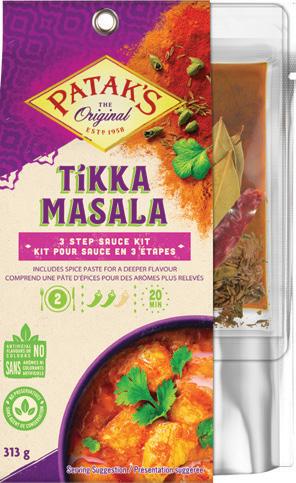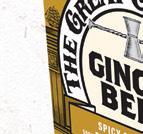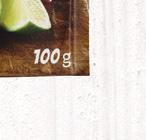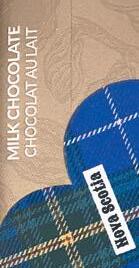Good
Say cheese … and
cheers!
Pairing two East Coast favourites for summer

Dragons Breath Blue
Food for thought
Indigenous chefs reclaim their heritage
Holmstead Feta
Knoydart Sharp
Cheddar with Truffle
Compliments of
Cows
Avonlea
Clothbound
Cheddar
Fox Hill SmokedGouda
Creating a destination
Trueman Blueberry Farms is more than berries
Spring/Summer 2023 GRACIOUS LIVING ON THE EAST COAST
Stuffed with rich cheddar cheese and smokey bacon



Available at




















GT 3 GRACIOUS LIVING ON THE EAST COAST 6 Exploring nutrition trends Learn the truth and make good choices by Maureen Tilley 10 Food for thought Reclaiming the history of rich and innovative indigenous food traditions edited by Crystal Murray 18 Say cheese … and cheers! Experts pair two East Coast specialties by Colleen Thompson Contents On our cover: Two East Coast favourites, beers and cheeses, go together naturally.
Good Taste is a special insert in Saltscapes magazine, published by Metro Guide Publishing, 2882 Gottingen St., Halifax, NS B3K 3E2. Tel: 902-464-7258, Sales Toll-free: 1-877-311-5877 Contents copyright 2023/2024. No part of this publication may be reproduced without prior written consent of the publisher. Printed in Canada. DRU KENNEDY 24 Creating a destination How agritourism has helped smooth the ride for this New Brunswick farm by Joan Allaby 29 Around the world With unique dishes and oodles of joy, Mary Grace Firmeza and Kriselda Alvarez bring Filipino flavours to Nova Scotia by Trevor J. Adams
Photo
by Steve Smith, VisionFire
MONICA ALLABY
STEVE SMITH, VISIONFIRE
Spring/Summer 2023 GRACIOUS LIVING ON THE EAST COAST G d Food for thought Indigenous chefs reclaim their heritage Creating a destination Trueman Blueberry Farms is more than berries Say cheese … and cheers! Pairing two East Coast favourites for summer Dragons Breath Blue Holmstead Feta Knoydart Sharp Cheddar withTruffle SmokedFoxHillGouda Cows Avonlea Clothbound Cheddar 18 24 29
BRUCE MURRAY, VISIONFIRE
IS YOUR MADE-RIGHT-HERE BUSINESS DIVERSE AND INCLUSIVE?










Youmaybeeligiblefora new award.
















Our new Atlantic Canadian awards program, DIVERSITY ATLANTIC AWARDS, PRESENTED BY TD AND ADVOCATE , centres around mentorship, so your business can be a part of building diversity and inclusion with partners across Atlantic Canada. Apply today. For more information on how to apply and prizes, visit diversityatlanticawards.ca
DIVERSITY ATLANTICAwards

“Diversity and inclusion, to me, are embracing everybody’s equality. There is no difference in how people should be treated, no matter where they are from, how old they are, or what skin colour they have.”
Seonju Lee , Br anch Manage r, T D C an ada Trust, S ussex NB








Exploring Nutrition Trends
Learn the truth and make good choices
By Maureen Tilley
Nutrition trends are forever coming and going. To help you learn which are really beneficial, we investigate five of the most popular.
A healthy gut microbiome
The urge to maintain a healthy gut microbiome has led many people to consume more probiotic supplements and foods such as yogurt, kefir, kimchi, and sauerkraut. Fermenting or pickling various vegetables has become a popular hobby. But people often don’t know what probiotics are or what a healthy gut microbiome is — its benefits and the various influences.

Our gut microbiome consists of trillions of healthy microorganisms including bacteria and yeast, mostly living in our digestive tract. Each species has its own function. Nutrition, genes, environment, stress, antibiotic use and illness can all influence them.
Probiotics play a role in digestion of certain nutrients, boost immune systems, and reduce harmful bacteria. They are promoted and researched for their digestive benefits including managing constipation and diarrhea. They may also be helpful in conditions such as irritable bowel syndrome and ulcerative colitis, but we need more
research. Recent and evolving research has shown the gut microbiome may benefit beyond digestion, in playing a preventative role in diseases such as cardiovascular disease, autoimmune conditions, allergies, diabetes, and even in improving mental health.
Taking probiotics can promote a healthy gut microbiome but if you’re already healthy, it’s likely unnecessary to buy them. There are several factors to consider beyond just taking a pill or foods. Stick to a daily regimen and ensure you’re using correct strains for the condition you’re targeting. Check the label to ensure the products has “live” and/or “active” cultures, or a list of bacteria added after processing. Food and supplement claims aren’t well regulated, so there’s no guarantee you’re getting what the products promises. Contact the company for any research performed on their product.
Prebiotic foods feed the gut microbes to promote quantity and variety of healthy microbes. Many prebiotic foods are high-fibre but not all high-fibre foods are prebiotic (but all fibre has health benefits). Focus on a variety of whole

NUTRITION
GT 6
BIGSTOCK/ BONDDLEGION
grains, fruits, vegetables, legumes, and prebiotic-rich foods such as chicory root, garlic, onion, apples, asparagus, bananas, and barley, to name a few.
Probiotics and prebiotics are generally safe but may be risky for some people, such as those who are immune compromised. If you are considering a supplement, consult a health-care professional.
Canned fish and shellfish

Once a food that many would scorn, canned fish and shellfish are now trending on social media. Beyond tuna, a variety of options include canned mussels, smoked oysters, sardines, salmon, anchovies, and herring. The little tins are packed with the benefits of convenience, affordability, and good nutrition. They’re as nutritious as fresh fish, containing protein, beneficial omega-3 fatty acids, and iron. Researchers have linked regular consumption of omega-3 rich fatty fish to many health benefits, including decreased inflammation and a lower risk of cardiovascular disease, kidney disease, and diabetes. Most canned options contain sodium, so look for the label with the lowest option. If it’s excessive, drain and rinse.
Mercury content in fish can be a concern. Larger fish can contain
Keeps food fresher–up to 3x longer*.

A fresh new look for your kitchen. And for your favourite foods.
Stunning looks. Unrivalled quality. And perfectly fresh produce. Bosch has done it again with the new FarmFresh System™ found in our Bosch 800 series refrigerator. Innovative yet easy-to-use, it features four freshness technologies that work together to keep your food fresher, up to 3x longer* .

Daley’s Brand Source Home Furnishings 1840 Lincoln Rd. Fredericton, NB (506) 458-9565
randall@daleysbrandsource.ca
Feron Kitchen Inc.
110 Chain Lake Dr., Unit 31 Halifax, NS (902) 450-5144 | 1-800-565-4044 dferon@feronkitchens.com
Dave’s Appliance
1 Sandy Point Rd. Saint John, NB (506) 634-1888 sales@davesappliance.ca
Creative Appliance Gallery
51 Raddall Ave., Unit 14 Dartmouth, NS (902) 481-3313
info@creativeappliance.ca
MacArthur Appliances Inc. 96 Mount Edward Rd. Charlottetown, PEI (902) 368-2200 macarthur@macarthurapp.pe.ca
Visit bosch-home.ca/en
a Bosch dealer for more information *As compared to a Bosch refrigerator without FarmFresh System™. Results may vary among different foods. E&OE © 2023 BSH Home Appliances Ltd. All rights reserved. Home Connect® feature on select models only.
Visit
GT 7 GRACIOUS LIVING ON THE EAST COAST
BIGSTOCK/ NEW AFRICA
high levels of mercury such as shark, swordfish and fresh tuna so consumption should be limited. General population should limit to 150 grams a week. Pregnant and breastfeeding people should limit to 150 grams a month. Kids up to age four shouldn’t exceed 75 grams per month, and the limit for those aged five to 12 is 125 grams.
Canned light tuna is low in mercury and doesn’t pose a concern. An exception is albacore (white) canned tuna; limit kids’ comsumption to 75 grams a week for 1-4 year olds, and 150 grams a week for kids age five-11 years. People who are pregnant or breastfeeding should limit consumption to 300 grams a week.
Visit Health Canada’s website for more information. bit.ly/3VJIzFv
Non-alcoholic beverages growing in popularity
The new Canadian alcohol guidelines (ccsa.ca/canadas-guidance-alcohol-andhealth) recommend drinking a maximum of two servings per week. Research shows higher consumption boosts your risk of cancer and heart disease.
Producers say demand for nonalcoholic beverages is growing. According to American research, sales of non-alcoholic beverages last year increased by 21 per cent. Options have expanded beyond the grape juice-tasting wine or watered-down light beer to a variety of beer, cider, and wine. They provide a refreshing taste, have the appearance of an alcoholic beverage, and deter people from questioning why you’re not drinking.
If limiting to two a week isn’t in the cards for you, there are benefits to just
reducing your intake. Adding nonalcoholic beverages will help.
Milk and milk alternative beverages
The options for milk-alternative beverages have expanded beyond rice and soy to various nuts and grains, including cashew, peas, macadamias, and oats. As popularity increases, many are switching to milk alternatives. For some, it’s due to taste, health issues, or personal preference, such as the desire to reduce one’s environmental footprint or animal-welfare concerns. The dairy and meat industry has one of the largest negative environmental imprints, producing 60 per cent of agriculture’s greenhouse gas emissions.

Nutritionally, plant-based alternatives are typically fortified with vitamins and minerals but it’s important to check the labels. They all have approximately similar calcium levels, with 23 to 30 per cent daily value (DV). Vitamin D is 10 per cent DV in milk alternatives, compared to 45 per cent in cow’s milk. High-fat cow’s milk and coconut milk are high in saturated fat, which can negatively impact cholesterol levels, but other options are low fat. Protein is where many of the milk alternatives fall short. One cup (250 millilitres) of cow’s milk contains 8 grams protein. Unless you choose soy milk or a protein fortified beverage, the protein content is low.
Plant-based and cow’s milk provide easy options packed with lots of good nutrition. For adults, follow your preference. For children, whole cow’s milk is recommended by the Canadian Pediatric Association, Dietitians of Canada and Health Canada, up until
age two — and between ages two to eight years, cow’s or soy milk.

Eat intuitively
There’s a new movement toward body positivity and self care while moving away from weight loss focused diets. This has brought about an increased interest in Intuitive Eating (IE), a program that two dietitians, Elyse Resche and Evelyn Tribole developed in the 1990s. It focuses on getting in touch with our innate sense of hunger, fullness, and satisfaction and avoiding labelling foods as good or bad.
IE is not weight-loss focused, and moves away from the dieting mentality of being told how and what to eat.
Dieting can lead to cycles of restriction, bingeing, and shame. IE doesn’t mean you eat whatever and whenever you want. It promotes an intuitive approach including physical and mental health. There are 10 key principles, which include respect, rejecting dieting, tuning into your hunger and fullness cues, coping with emotional eating, gentle nutrition, and movement.
Research shows strict dieting doesn’t result in sustained weight loss or improved psychological well-being. While more research is needed on IE, studies have shown positive affects on cholesterol, diabetes, and blood pressure. More importantly, benefits include improved psychological well-being related to body image and self-esteem.
IE is a good approach for anyone looking to move away from rigid dieting and have an improved relationship with their body and food. Work with a dietitian if you’re considering this path. Learn more at intuitiveeating.org
GT 8 NUTRITION
GETTYIMAGES:ALEXPRO9500
"Options for milk-alternative beverages have expanded beyond rice and soy"
LOOK FOR US AT YOUR SOBEYS ATLANTIC LOCATIONS


Nandos Perinaise
Original 450ml



Nandos Peri-Peri Medium 250ml





Pataks Butter Chickpeas Rte 285g

Pataks Butter Chicken Sauce 400ml




Pataks Tikka Masala 3-Step 313g



Bring Your Meals to Life - for over 65 years to deliver delicious, authentic Indian fl avour to consumers around the world. Get inspired by Patak’s®
The Grt GentGinger Beer 6pk 1500mL







The Grt GentWatermelon 6pk 1500mL



Give your cocktails a kick. Naturally fl avoured with ginger extract, our Jamaican-style Spicy Ginger Beer radiates intensity. Its unique kick makes it a favourite!
Delicious on almost anything, Nando’s range of PERi-PERi sauces combine fl avour with heat that will satisfy the fl avour profi le from a PERi-PERi beginner to a fi ery heat seeker. There is something in our range for all Flavour lovers alike!
Tabasco Sauce









Original 24x57mL












Endlessly versatile, enhance the fl avor of any food with a dash of our signature sauce




Twinings Lemon Ginger







Herb Tea 20s 30g
Twinings Peppermin
Herb Tea 20s 40g
A delicious, invigorating herbal tea made with spicy ginger and the tangy fl avour of lemon.


Briannas Asiago


Caesar Dressing 355ml

Briannas Dijon


Honey Mustard


Illy Espresso Intenso





Ground Coffee 250g

Intenso, bold roast coffee has a pleasantly robust fi nish, with warm notes of cocoa and dried fruit.

So Veggie So Wise
Veggie Filets 90g

So Veggie So Wise
Veggie Mince 100g


The fi rst shelf-stable plant-based protein!
- Modern food for modern lifestyles





Dressing 355ml
Classic fl avors, deliciously reimagined

Find us at your local
Food for thought
Reclaiming the history of rich and innovative Indigenous food traditions
Edited by Crystal Murray
Food is the tie that binds, bringing people and communities together and connecting us to our past. For Indigenous people, the bonds between food sources, nature, and spirituality may be one of the most profound relationships in the world. On the following pages, you’ll meet four East Coasters who are putting their own spin on Indigenous culinary experiences and finding ways to honour the teachings of their ancestors. These are their stories.

As told by Jenna White
Jenna’s Nut-Free Dessertery, New Brunswick
My Nanny Fowler taught me how to cook and bake using an old stove at the camp on the Renous River, and that ignited the flame inside of me. Not only was food universal, it was used for gathering those you loved and feeding one’s soul in more ways than one. Food could be gathered in the wild, cooked with the fire, baked with the fire. It was something you could create out of simple ingredients found outside where we played with virtually no equipment — flat stones and sticks will do.
One thing was apparent from both my early years in Ontario and then when we moved to New Brunswick: nature was abundant and nature could provide … what we need to thrive, like we have since time immemorial.
My life turned upside down six years ago. I had an intense allergic reaction
to nuts, something I had eaten so many times before. I live only three minutes from the hospital, but almost didn’t make it. I was in my 30s and food, something that always brought me joy almost killed me. Not long after that I lost a good chunk of my vision. My independence was gone, I would never drive again, had a hard time recognizing people, and I would never
peer up at the twinkling stars at night.
After some time adjusting and feeling bad about myself and my limitations, I decided that I needed more. I needed my children to see that even when life doesn’t turn out as planned, you can take control and work with what you are given.
From knowing all of this, I became so many things: a wife, a mother, a proud
GT 10 CHEF PROFILE
Indigenous chef, business owner, Indigenous food consultant, festival founder, and a speaker.
So, I went back to what made me happy: feeding people.
In June 2019, I set up a couple of tables at the Boyce Farmers Market selling nut free baked goods. It was a great place to test my niche market. Not only was I 100 per cent nut free, I was also a 100 per cent Indigenous-owned business. I was just getting going and breaking sales (records) week after week. And then the pandemic hit.
I wondered, do I bow out? Do I wait it out? I spent months taking every online seminar I could find. I built a business plan and I heard “no,” so many times. Finally, Women in Business New Brunswick connected me with a food consultant who was able to develop my recipes into baking mixes and then I opened my own bricks and mortar shop.
In June 2021, I opened the doors of Jenna’s Nut-Free Dessertery and welcomed customers to a place that represented my roots and honoured the land that I now call home. There is a beautiful mural created by Samaqani Coqum of Tobique. She blended and mixed it with Wolistoquey art to create something that brought my space to life.
I honoured the importance of
Bourbon Maple BlackBerry
Fire-roasted Trout or Salmon

4-6 servings
1 whole fillet of trout or salmon with skin on
1 pinch each of salt, pepper and burnt pine needles
For the glaze
¼ cup (75 mL) butter
¼ cup (75 mL) Wabanaki maple bourbon syrup
¼ cup (75 mL) blackberries
1 tsp (5 mL) balsamic vinegar
birchbark by building my tables and counters out of birch with my own two hands.
My menu has nods to my Indigenous heritage. I saw the culture represented in the space, but something was still missing, so I created a traditional meal series, held four times a year, to allow people to experience Indigenous cuisine. I believe that by using many traditional ingredients that non-Indigenous people have already adapted into their own way of eating, that we create a new bridge towards reconciliation.
From the success of this endeavour and being inspired at my first Indigenous tourism conference, I launched the A Taste of the Atlantic festival that is not only a beautiful celebration of Indigenous cuisine and culture, but a way to create a network of Indigenous chefs. We can all grow together and create a group of likeminded people with their own unique skill set and knowledge.
There are so many amazing opportunities when we work together to create new visibility in new spaces and inspire our youth to see our culture in a whole new light. This helps us all to dig a little deeper into our culinary history and find ways to bring back some of what was lost, including that feeling of connectedness.
Get your fire ready with a good bed of coals (you don’t want big flames to reach the fish). Mix a pinch of salt, pepper, and burnt pine together. Sprinkle over your fish. Place all other ingredients in a cast iron pan. Place the fish skinside down on a grill over fire. Place cast-iron pan on the grill. Once the butter has melted and starts to bubble, brush the fish with the glaze. As the glaze cooks down, the flavour complexity will change and add layers of taste to the fish. The fish is done when it starts to flake or you can lift off the skin.
Remove the fish and pan from fire. Plate the fish then drizzle with glaze. It pairs well with wild rice. Note. You can make this recipe in the oven or on the barbecue. Create sauce on stove. Brush fish every 5 min.
Recipe by Jenna White.
GT 11 GRACIOUS LIVING ON THE EAST COAST CHEF PROFILE
STEVE SMITH, VISIONFIRE
STEVE SMITH, VISIONFIRE
Serves 4
As
told by Chef Richard Charron
Noble Chef, Prince Edward Island
I am Metis but I have been very disconnected from my roots. I got my status about five years ago and am reconnecting to my heritage.
My partner Rachel and I were working out West when the pandemic hit. We were both working in high-end hospitality businesses and lost our work. To be honest, I was starting to become a little disenchanted with my job. We decided to move back to where I grew up, in Charlottetown, P.E.I., and we have had incredible support from the Indigenous community.

Recently we were invited to attend a national Indigenous tourism conference in Winnipeg. We met a lot of renowned Indigenous chefs. This was an inspiring experience and I could feel myself becoming more connected. I have some real homework to do.
For the last 20 years, I have been working in high-end Italian and French cuisine. We had already branded our company Noble Chef.
Pan-seared Scallops with Corn and Squash purées, Maple Gastrique, Fried Sage

12 large fresh sea scallops, patted dry
1 tbsp (15 mL) salt
2 tbsp (30 mL) olive oil
2 tbsp (30 mL) unsalted butter
1 cup (250 mL) fresh corn kernels (from 1-2 ears of corn)
½ cup (125 mL) chicken stock
½ cup (125 mL) heavy cream
1 tbsp (15 mL) unsalted butter
1 medium sized butternut squash, peeled and cubed
½ cup (125 mL) chicken stock
½ tbsp (10 mL) salt
¼ cup (65 mL) maple syrup
¼ cup (65 mL) apple cider vinegar
1 tbsp (15 mL) unsalted butter
12-16 fresh sage leaves
Vegetable oil for frying
Start by making the corn purée. In a small saucepan, heat olive oil over medium heat. Add the fresh corn kernels and cook, stirring occasionally, until the corn is tender, about 5 minutes.
Add the chicken stock and heavy cream to the saucepan and simmer. Cook for 5-10 minutes, until the liquid has reduced slightly and thickened. Remove from heat and blend the mixture in a blender or food processor until smooth. Season with salt to taste.
Next, make the squash purée. In a large saucepan, combine the cubed butternut squash and chicken stock. Bring to a simmer and cook for 10-15
GT 12 CHEF PROFILE
GLEN STRICKLEY GLEN STRICKLEY
But now I want to do more to incorporate that Indigenous flair and bring more Indigenous ingredients into the cuisines that I have been creating. We have added “Indigenous Curated” to our brand of non-perishable food items. We have a varied offering of pickles, spices, rubs, infused salts, infused oils, and some baked good inspired by my family recipes. We have a butter tart that my mom would make that has been in my family forever, and a bread and butter pickle recipe that's been in my family since my great great-grandmother.
We are the beginning stages of moving into a catering line with Noble Chef that is going to lean more into the Indigenous curations and experiences. Moving forward, we want to create Indigenous experiences with the Italian and French flair that we have learned over the years. As I learn more about my Indigenous culture, we will be throwing this into our eclectic mix of cuisine.
We call ourselves Noble Chef as we are a noble people. Rachel says she knows it sounds a little corny, but we are good-hearted, genuine people and we wanted to make sure that our brand represented that.
Recently we have been getting more recognition for our Indigenous offerings
and catered an event on P.E.I. where the customers wanted an Indigenous experience. I was very straightforward with them about our degree of expertise with that type of cuisine, but I did a lot of research. Since then, I made bannock for the first time in my career. We were catering an event being hosted at Abegweit First Nation. There is nothing more nerve-wracking than serving bannock to an Indigenous chief but he said I knocked it out of the park.
There are a lot of doors opening for us. By accident, we ended up at a market we thought was to sell our product, but it was a wholesale market where we ended up with 18 acquisitions, and will be in a number of gift shops across P.E.I. this summer.
From a catering inquiry, we were invited to sit down with some members from Abegweit First Nation. We thought they wanted a catering job but in fact they wanted us to lease out their kitchen to produce our wholesale product and they want us to be on site as much as possible and would love to have our food on the Abegweit First Nation land.
We realized that we can’t do it all and will likely hire prep cooks to keep our wholesale program efficient this summer; because we have also opened a bar.
As told by
Lauralee Ledrew
Upper Humber Settlement, N.L.
I grew up in Fort McMurray, Alberta. I am one of those children from two Newfoundlanders that were sent away because there was not much for them here. My Indigenous heritage comes from my mother’s side of the family. We are from the Qalipu First Nation, a landless First Nation with Mi’kmaw people living all over Newfoundland and Labrador.
My mother didn’t grow up with a strong Indigenous identity and when she was young it was something that was shamed and frowned upon to identify as Indigenous. I grew up away from my people and it made it difficult to understand my mother and my Indigenous identity.
My mom made a lot of bannock when we were kids. She was known for her amazing bannock and all the neighbourhood kids would come to our house after school to have some. She said she never had a recipe, so she was unable to share it. Even when I lived on my own, she would mix all the ingredients together and put it in a margarine tub and all I would have to do is add the water.
minutes, until the squash is tender. Drain any excess liquid and blend the squash in a blender or food processor until smooth. Season with salt.
To make the maple gastrique, combine maple syrup and apple cider vinegar in a small saucepan. Bring to a simmer and cook for 5-10 minutes, until the mixture has reduced by about half and thickened slightly. Remove from heat and whisk in the unsalted butter until fully incorporated.
For the fried sage, heat vegetable oil in a small saucepan over medium-high heat. Add the sage leaves and fry until crispy, about 30 seconds to a minute.
Remove sage leaves from the oil using a slotted spoon and transfer to a paper towel-lined plate to drain excess oil.
To cook the scallops, season them generously with salt and pepper on both sides. In a large skillet, heat the olive oil and unsalted butter over medium-high heat until hot. Add the scallops and cook for 1-2 minutes on each side, until golden brown and cooked through.
To assemble, spoon corn purée and squash purée onto plates. Top each plate with 3 cooked scallops. Drizzle maple gastrique over the scallops and around the plate. Garnish with fried sage leaves. Serve immediately.
My mom moved home, back to Newfoundland, when I was a teenager, and this land quickly became my home. My identity means everything to me. I went on a journey in my own way and through guided meditation and teachings of the medicine wheel I started to learn and heal.
So, I brought together bannock and the medicine wheel in my business at Upper Humber Settlement to share my story. While I lead these experiences and share in preparing the food, I always learn new things from my guests. The more I learn about Indigenous history and culture the
GT 13 GRACIOUS LIVING ON THE EAST COAST
CHEF PROFILE
more I understand reconciliation and my mother’s own story.
My Indigenous heritage means a lot to me. I have always had a strong connection to the land and consider myself an environmentalist. As I learn more about my own Indigenous identity, I feel an even stronger connection to the land.
I could not do what we do here on the farm without my husband, Mark. The health of the land is our priority, and we believe in building soil health. Biodiversity is key to our farming success and so is our approach to everything we do. We collaborate and make decisions together.
We have three culinary experiences at Upper Humber Settlement. We are not a restaurant, so to come and eat our food you must stay at our bed and breakfast and participate in our FarmStay. For the Medicine Wheel experience, we sit around the fire circle, and I share what I know about the circle, my own story and a guided meditation where I replicate the experience that I had. I do not offer teachings or workshops, just intimate and immersive storytelling. Of course, there is bannock that the guests roast and season over the fire.
We also offer several experiences. One is a four-course farm-to-table dining experience. Guests can be as involved as they like. They can harvest their own vegetables as part of an immersive farm tour and explore the local museum, or enjoy a day hiking and return to an intimate dinner experience.

I am a hunter and gatherer and I like to share my harvest — moose, caribou, and small game— with guests after exploring our nature trail. We often incorporate these flavours with our Farm and Forage Experience. It’s a simple experience but very land based and educational, all about our connection to the Earth, to the stories and the flavours of the land because there are so many edible things here. I love sharing our food, stories and culture with visitors from all over the world.

GT 14 CHEF PROFILE
DRU KENNEDY
DRU KENNEDY
Steak with Alder Cream Sauce
Alder Cream Sauce
½ cup (125 mL) butter
1 can (170 mL) Fussel’s Cream (any heavy cream will do)
2 garlic cloves
6-10 peppercorn
1 tsp (5 mL) kosher salt
6 fresh or dried sage leaves
6 fire roasted alder catkins, the flowering spike of an alder tree
Moose, caribou or venison steak
Extra butter for cast iron pan
Prepare meat in advance using a tenderizer and add kosher salt and pepper to both sides. Let sit.
Use a small saucepan over the open fire to melt the butter. While butter is melting place garlic, peppercorn (use less if you prefer less pepper), salt, sage, and alder to your mortar and pestle. Grind until all ingredients are well blended and set side.
Shake the Fussel’s Cream can well and keep an eye on your butter in the saucepan, taking care not to brown it. Once it is melted, add cream. Use a small whisk or spoon to blend cream and butter. Let it return to a boil.
While you keep an eye on the sauce and continue to stir, place your cast-iron pan on the fire to heat. When the pan is hot enough for the butter to sizzle, add steak. Cook to desired temperature. You can also opt to cut the meat into strips to cook over the fire or in the pan.
When the sauce boils, blend together cream and butter until smooth. The sauce will thicken slightly as it heats. Add ingredients from the mortar and stir. Remove from heat, or keep on low if your meat is not finished.
Plate your steak. Serve alder cream sauce over the meat. An ideal pairing with a pasta, or roasted carrots and beats.
*This recipe can easily be done over a kitchen range. Alder cream sauce is a great sauce to use as a pasta sauce as well for a vegetarian dish.
Recipe by Lauralee Ledrew.
As told by
Geordy Marshall
Eskasoni First Nation, N.S.
My culinary journey goes back to when I was about eight years old. My mother wasn’t in the picture when I was a child so my grandmother Malia’n (the Mi’kmaw word for Maryann) Marshall took a big part in filling that role and making food for family. Taking care of people was all that she knew. She loved to bake and cook, and I wanted to emulate her. She was such a focal point for my entire clan. We come from the lineage of the


Mi’kmaw Grand Council. My great-greatgrandfather Gabriel Syliboy was the first elected Mi’kmaw Grand Chief, in the early 1900s. He was the Grand Captain of the Mi’kmaw Nation at that time. The Nation went for an election amongst their people, and he was chosen unanimously by his colleagues to be the first elected Grand Chief.
My grandmother was a hereditary grandmother and a descendant of this
GT 15 GRACIOUS
CHEF
LIVING ON THE EAST COAST
PROFILE
BRUCE MURRAY, VISIONFIRE
legacy. Grandmothers are held in very high esteem in our culture — the ones who teach everyone.
As a child I asked my parents if I could start cooking. They told me that they didn’t think I could cook at the age of eight and they said that when I could reach the top shelf of the cupboard then I could start cooking. A couple of years later I went to Walmart to buy a stool my father needed to put in the bathroom. That stool never saw the bathroom. It went straight the kitchen and I reached for the top cupboard, and they said I guess you can cook now!
The first thing I made was spaghetti and pork chops. My stepmother was Italian, so we had plenty of spaghetti growing up and I still love cooking Italian food.
There have been adaptions to all kinds of cuisine and as food got colonized it changed. Mi’kmaw food is all about ingredient utilization. Originally my ancestors would have spent their summers by the coast living off lobster, fish, clams, mussels, and oysters. At this time, they lived a very healthy rich lifestyle. People who eat these foods now are typically affluent when it was once just an everyday cuisine for my people. This is what the definition of what a moderate livelihood was. It was having these resources available and not having to pay anyone for them. The colonial mindset is that you owe someone, and we didn’t think this way. Our food culture was about sharing. If I hunted a moose and brought it back home, I would share it with my family and community and the person who was very good with agriculture shared what they had.
Today, many of my people have lost the taste for these types of foods and eat a lot of what people call poverty foods or survival foods. We might not be able to save this generation of people living on processed foods, but we might be able to teach their children and grandchildren.
I have never worked outside of my community other than teaching an introductory language course at Cape Breton University for two years. I have always worked for the people in my community in education and
administration. I have been great at providing for my community but not providing for myself. In realizing this I knew it was time to go to cooking school. This spring I will be graduating from the Culinary Institute of Canada in Charlottetown, P.E.I. I am 31 years old. I have been cooking for 20 years and now I understand the bigger picture and where I fit in and that is taking part in the revitalization of our cuisine and take it back home.
There was no Mi’kmaw food represented at culinary school so I asked if I could develop a standardized recipe for our traditional brown bread. Now when other Mi’kmaw students go there they will see their brown bread recipe.
I am interested in bringing my cuisine back to my people so that it will never be lost. I am passionate about promoting my language, our culture, our cuisine. We are just at the tip of ... this renaissance of discovery and sharing Indigenous cuisine. I think we are ready to learn what it is to truly be Mi’kmaq.

I went to culinary school for myself, and it helped me heal but, in the end, I am doing this for my people. When I am done on this earth, I will be able to say I am proud of what I have done, and I will leave a legacy for people to utilize and finish what I have started. That is the goal.
Four-Cent Ke’k
4 cups (1000 mL) all-purpose flour
1 tsp (5 mL) salt
1½ tbsp (25 mL) baking powder
1 tbsp (15 mL) sugar
2 cups (500 mL) water
Oil
Butter
Mix dry ingredients very well, add water, and mix until there’s light dough consistency. Heat frying pan and add oil. Add dough and level, while making a dip in the centre to help with even cooking.
Cook four-cent bread on medium low until golden, then flip, and cook the other side until golden. Flip again to increase the colour of the bread on both sides.
Butter each side and flip to cook the butter into the crust. Let cool for 15 mins and enjoy.
Pkwimanomi
11 lbs (5 kg) blueberries (fresh or frozen)
2 cups (500 mL) maple syrup
3/4 cup (175 mL) water
Cook berries in water until water reduces, add maple syrup, and keep reducing to thicken the berry sauce.
Recipes by Geordy Marshall.
GT 16 CHEF PROFILE
BRUCE MURRAY, VISIONFIRE
On the south shore, staying in shape for February’s lobster crawl is all about finding the right balance – like A local craft beer in one hand, and a lobster roll in the other. we work up an appetite by hiking our coastal trails, biking our quiet roads, and gliding on top of the water with help from a kayak, canoe, surf or paddle board. We then focus on our core strength by fueling up at the unique cafes, bakeries, restaurants, and pubs that dot our beautiful coast. Come and workout with us, then tuck in at unique places to rest your mind, body, and soul.







DINE IN/TAKE OUT Fancy Pants Cafe Mon - Fri 7:30 - 4 | Sat & Sun 9 - 3 807 King Street, Bridgewater, NS 902-530-2548 Fancy Pants Cafe Express | Open 9 - 4 daily 135 North Park Street, Bridgewater, NS (Located inside the LCLC) 902-530-4114 Fresh, local, organic Cafe & Eatery
SUMMER IS SHAPING UP DELICIOUSLY
LOBSTERCRAWL.CA SCAN AND MAKE A PLAN! @novascotialobstercrawl
Say cheese … and cheers!

Experts pair two East Coast specialties
By Colleen Thompson
Beer’s freshness, carbonation, and intricate flavours make it the perfect pairing with cheese. And while wine and cheese pairing are common knowledge, learning to pair beer and cheese can unlock a whole new world of flavour.
“Beer is so uniquely positioned to be great with cheese,” says beer sommelier Roger Mittag. “Both are originally farmhouse creations that have been fermented and aged, and the characteristics of beer help to bring out the best of both. The sweetness in beer (from malt) often helps reduce cheese's saltiness or acidity. Carbonation in beer (plus bitterness from hops) helps cleanse our palates just a little so that we can enjoy beer and cheese without losing either.”
There are no hard-and-fast rules when pairing beer and cheese, but there are some principles to keep in mind.
Everybody’s palate is different. “Some pairings might be home runs for you and not for your friends, and that is OK,” says brewer Jeremy Taylor from 2 Crows Brewing in Halifax. “These events are best if they spark conversation. They’d be boring if everyone was munching and nodding their heads.”
Have fun. “My best suggestion is to get a variety of cheeses and a variety of beers
and let people try many combinations,” says Mittag. “Most beers are really decent pairings, but every once in a while, you'll get something that blows your mind.”
Strong cheeses need strong beers. Light cheeses need light beers. “Balance, intensity, and weight of cheese and beer should be similar,” says Gregory Burns, executive chef at the Prince George Hotel in Halifax. “For example, a barrel-aged beer with a high ABV (alcohol by volume) won’t work with a mild light cheese. We are looking for similar intensity.”
Pairings should complement. “It might help to think about what you would normally pair the cheese with,” explains Taylor. “Do you like a bit of honey with cheddar? Look for a sweeter beer to pair. Think citrus flavours would work well with fresh, soft cheese? Look for a wheat beer with citrus notes.”
What grows together, pairs together. “Often in the world of wine, we speak of terroir and what grows together, pairs together,” says Burns. “Sol beer from Mexico, for example, pairs great with avocados (think of guacamole and chips). For instance, a local way of thinking is Propeller Brewing’s Bohemian-style pilsner pairs beautifully with local oysters and mussels.”
Some pairings to try
Dragon’s Breath Blue with stout or IPA
Dragon’s Breath Blue is a surfaceripened blue cheese that has become cheesemaker Willem van Den Hoek’s signature piece. Produced at That Dutchman’s Cheese Farm in Upper Economy, N.S., the black wax-covered cheese is a complex creamy, sweet, and tangy layering. To eat it, slice off the top and scoop out blobs of pungent deliciousness. When selecting a beer to pair with the richness of blue cheese, a malty, dark porter with notes of bitterness from the hops cut through the creamy richness of the blue and complements the texture and flavour. “I would use a stout or an IPA, possibly even a fruit beer,” says Mittag. “For a stout, Cereal Killer from Big Spruce is a must-have. The glory here is that the chocolate and coffee notes reduce the impact of the saltiness and pungency of Dragon’s Breath. For an IPA, Propeller’s Galaxy would be beautiful. The tropical fruit notes would bring down the pungency a touch, and then we have the tropical fruit sweetness working in harmony with the saltiness of the cheese.”
Knoydart Sharp Cheddar and Truffles with brown ale
Nestled on the bucolic coastline of
GT 18 FRESH AND LOCAL
Local brews go together beautifully with cheeses from throughout Atlantic Canada

Big Spruce Cereal Killer Stout
2 Crows Space Words RhubyUpstreetSocial
Holmstead Feta
Fox Hill SmokedGouda
Knoydart Sharp Cheddar with Truffle
Cows
Avonlea Clothbound Cheddar
GT 19 GRACIOUS LIVING ON THE EAST COAST FRESH AND LOCAL
STEVE SMITH, VISIONFIRE
the Northumberland Strait, near Merigomish in Nova Scotia, is a familyowned dairy making a range of organic cheese curds and cheddar cheese. With passionate cheesemaker Frazer Hunter at the helm, the dairy is renowned for its grass-fed Holstein and Jersey cows, who transfer the unique terroir of the area and a salty quality from ocean breezes into each cheese. A piquant cheddar combined with truffles brings an earthy flavour. “For this cheese, we want a beer with some depth in savoury notes, preferably a brown ale or a Vienna lager from Tatamagouche Brewing,” explains Mittag. “Instead of keeping things separate, we want to highlight the more interesting parts of the cheese. In this cheese, we also have truffles. which need a beer with some umami or earthiness. A brown ale is perfect.”
Fox Hill Smoked Gouda with Irish red ale
A sixth-generation dairy farm, Fox Hill Cheese House in Port Williams, N.S., produces cheese from the milk of the
farm’s 50 Jersey and Holstein cows. The salty marsh of the nearby Wellington Dyke and the rich land surrounding Fox Hill Farm, where most of the forage for the herd grows, results in a uniquely flavoured feed that leads to high-quality cheese. This semi-hard gouda has a slight tanginess and subtle smoked flavour. “It’s got wonderful buttery notes and depth of flavour,” says Mittag. “When there’s an added touch of smoke to it, you need a beer that has excellent carbonation to cut the richness of the cheese and balance out that smoke. I would pair this with an Irish Red Ale like Boxing Rock Temptation Red or a classic IPA like Gahan 1772, where the malt body helps to bring out the caramel, and the citrus reduces the smoky notes.”
Cows Avonlea Clothbound Cheddar with fruity IPA
Crafted in the fashion of classic British cheddars, Cows Creamery’s Avonlea Clothbound Cheddar, made in Charlottetown, P.E.I., follows a recipe that originated from the Orkney Islands found north of mainland Scotland. The cheese is handcrafted using milk sourced from Holstein cows on small local farms nestled among the rolling hills of Prince Edward Island. This natural milk, gently warmed without pasteurization, encourages the nurturing of beneficial microbes that enhance the cheese’s depth of character and overall flavour. The iron-rich soil and salty air of P.E.I. further enhance and refine the cheese’s flavour profile. Wrapped in a breathable cloth, this cheddar ages superbly to develop an even richer, robust flavour.
“Cow’s Clothbound Cheddar has a nice fruity note to it and a bit of a tang to the finish, so I would pair with 2 Crows Space Words,” says Taylor. “It’s a super fruit-forward IPA with massive amounts of tropical-tasting hops. If you want to kick the pairing up a notch, drizzle a bit of local honey on that cheddar. The extra sweetness brings out the best in the beer and the cheese.”
Holmstead Feta with witbier or light lager
Nick and Susan Tziolas established Holmstead Cheese in scenic Aylesford,
N.S., in 1985 and started selling their handmade feta door-to-door. Made with cow’s milk, this semi-soft feta, cured in 17 to 20 per cent salt brine, has a subtle sweetness and crumbly texture. “If I want to reduce the saltiness, I recommend a lager or a fruit beer like Upstreet Brewing’s Rhuby Social — a strawberry, rhubarb witbier," says Mittag. “But if I want to bring out the barn and grassy character of a feta, I recommend something with a bit of its own funk like 2 Crows, out of the beautiful foeders (oak barrels).”
“Holmstead Feta, with its tangy, fresh, and briny character, will work nicely with our AC Light Lager. AC is bright, fresh, easy, and crisp and will serve as a bright little complement to the cheese,” says Taylor. “Nothing overpowering, just a hint of malt-bready character.”
Dragon’s Breath Blue Cheese Dip
Makes 3 cups (750 mL)

1 cup (250 mL) sour cream

1 ½ cup (375 mL) Dragon’s Breath Blue Cheese
½ cup (125 mL) mayonnaise
1 tbsp (15 mL) garlic, minced
2 tbsp (30 mL) buttermilk
1 tbsp (15 mL) lemon juice
4 dashes Tabasco or your favourite hot sauce
4 dashes Worcestershire sauce
1 tbsp (15 mL) kosher salt

1 tbsp (15 mL) black pepper
Combine all ingredients in a food processor until smooth. Alternatively, mix by hand. A wooden spoon or whisk would work best.
GT 20 FRESH AND LOCAL
Available at Sobeys and Foodland Atlantic
BRUCE MURRAY, VISIONFIRE
Knoydart Sharp Cheddar Scones

6 ¼ cups (1,500 mL) all-purpose flour
3 tbsp (45 mL) baking powder
2 tbsp (30 mL) sugar
2 tsp (10 mL) salt
1 cup (250 mL) butter, cut into cubes
1 cup + 1 tbsp (265 ML) water
1 cup (250 mL) buttermilk
1 egg
2 cups (500 mL) Knoydart Sharp Truffle Cheddar, grated
Place first four ingredients in a bowl and mix them. Add butter and crumble by hand. Add liquids and combine them by hand. Before liquids are fully absorbed, add cheese and keep kneading on the counter.

Roll dough out with a rolling pin at ¾ in (2 cm) thickness and cut out scones using a 2.5-inch (6.5-cm) round cutter.
Bake at 400°F (205°C) for six minutes, then rotate and bake for another five minutes.
Don’t store unbaked dough in the freezer for more than two days.

GT 21 GRACIOUS LIVING ON THE EAST COAST FRESH AND LOCAL
July 11-16, 2023 halifaxjazzfestival.ca
BRUCE MURRAY, VISIONFIRE
Executive Chef Gregory Burns
BRUCE MURRAY, VISIONFIRE
Made Right Here
















































































































Feeding our friends and neighbours in Atlantic Canada since 1956.





Available from March to November at your Atlantic Sobeys, Foodland, and select local markets.



★
★






































































































halifaxspice.com Follow us SCAN ME! G Let us know @eggfarmersofns if you try an egg on your burger this summer! Great Canadian Burger Recipe G Ö e Made Right Here ★ We Nova Scotians love our chocolate, we also love our history! Look for us all around the province and on our website. If you have an event, we can provide custom chocolate for you to show the love. ce chapelcovechocolate.ca Chocolate in this product is made from sustainable cocoa sourced from third party certified farms.
Creating a destination
How agritourism has helped smooth the ride for this New Brunswick farm
 By Joan Allaby
By Joan Allaby
Tom Trueman’s roots in the Tantramar region of New Brunswick run deep, almost 250 years deep. He’s the owner and operator of Trueman Blueberry Farm on Etter’s Ridge Road near Aulac, and the eighth generation of the Trueman family to farm in this region along the Nova Scotian border.
Trueman’s ancestors emigrated to Canada in 1774 and established Prospect Farm — “the home farm” as he refers to it — a short distance down the road from his place.
“The Truemans were tenant farmers from Yorkshire, England, who left because the rent on the land was becoming too expensive and they were looking for new opportunities,” he explains. “There are Truemans all over North America now who trace their roots back to this farm.”
The agricultural tradition has continued in Tom’s branch of the family. He grew up helping out on the family dairy farm, working alongside his grandfather, father, and uncle. When Trueman decided to start his own business, running his own farm seemed a “natural path.”
In 2001, Tom acquired his first blueberry field. Today, Trueman Blueberry Farm includes several hundred hectares of wild blueberries and an apiary. He sells the bulk of wild blueberries to Oxford Frozen Foods, in nearby Oxford, N.S., where

MEET YOUR
LOCAL FARMER
GT 24
The farm now hosts an annual tulip festival in late spring.
SUBMITTED BIGSTOCK/ NETPIX
workers freeze and package them for distribution worldwide.
Tom and his wife, Krista, have worked over the last two decades to develop their blueberry business, but it hasn’t been easy. Blueberry growers face the same challenges of any farmer: pests, disease, labour shortages, and the weather.

Perhaps one of the more difficult challenges for growers like Tom is the cyclical nature of the business. About seven years ago, the Truemans took their first steps into the agritourism sector to help buffer the ups and downs of the marketplace.
“In 2015 to 2016, we were heading into a lower-price trend,” he explains. “As a business, we decided we should diversify a little bit. We had available land, so we decided to plant some permaculture crops for a U-pick.”

In 2016, the Truemans put in their first raspberry plants. The following year, with the raspberries starting to bear fruit, they built a small farmstand to accommodate the U-pick, started selling fresh homemade bread, and planted a sunflower maze. They made enough money that year to expand the U-pick, planting more raspberries, plus highbush blueberries.
Then, in early 2018 with snow covering the fields, the Truemans attended an ice cream-making workshop. They spent the rest of the winter honing their skills and that summer, hired a full-time ice-cream maker. It was a decision that would elevate the farm’s retail business.
“It just exploded,” says Tom of the dessert’s popularity.
The original farmstand has expanded four times to accommodate the busy ice-cream operation and retail shop. This year, the family added on a large barn-like space with picnic tables for customers to gather and even listen to live music on occasion.
The sunflower maze now covers 2.4 hectares with 250,000 blooms. The U-pick operation has also grown to include several varieties of raspberries and highbush blueberries, lowbush blueberries, pumpkins and, for the first time in 2022, tulips.

With activities to please kids, like a giant inflatable bouncy pillow and a wagon train ride, Truemans has become a family destination. On a typical summer weekend when the weather is nice, the Truemans say they have 800 to 1,000 visitors a day. Tom expects 100,000 this year.


While the ice cream is a big draw, Trueman believes that customers visit for the rural experience. “We think that the fact that people can come and enjoy the farm, the pond, kids can play, is part of the attraction. Certainly, the ice cream is good, but it’s more than that.”
For some customers, a trip to
GT 25 GRACIOUS LIVING ON THE EAST COAST
Clockwise from top left: Nothing says summer like icecream; Tom Trueman in his blueberry field; fun on the jumbo jumper; the farm grows an annual sunflower or corn maze.
MEET YOUR LOCAL FARMER
SUBMITTED SUBMITTED SUBMITTED
MONICA ALLABY
The Scoop
The first Saturday of February was cold and snowy, but customers were lined up outside the door at Trueman Blueberry Farm. The farmstand was opening for the 2022 season, and its loyal customers were eager for their first ice cream of the year.

Located just a short drive off the Trans-Canada Highway near Aulac, N.B., Trueman Blueberry Farm is known as the place to go for a generous scoop of homemade ice cream or a celebratory ice cream cake.
The Truemans began making and selling ice cream from their farmstand in 2018 as part of their retail agri-tourism business, a sideline to their commercial blueberry farm. Now, the ice cream draws thousands of visitors throughout the year.

Workers make the ice cream from a custom cream blend created by the family and that P.E.I.’s ADL prepares.
In the summer, staff make 60 to 80 three-gallon tubs of ice cream four days a week in the two batch freezers. Once the cream transforms to the consistency of soft serve, they mix in the flavours. They then chill the ice cream in a -34° C blast freezer. “The quicker you can get the ice cream to -25° C,” explains Tom Trueman, “the better quality of ice cream you’ll have.” When the ice cream is set, they store it in the -23° C walk-in freezer, then warm it to -16° C for serving.
Trueman’s serves about 50 flavours. Along with mainstays such as strawberry, chocolate, and butter pecan, it offers peach cobbler, lemon raspberry, Fundy fog (their version of Moon Mist), and other intriguing flavours, plus seasonal specialities like rhubarb and pumpkin spice latte.

All of the ice creams contain at least
HELPING YOU MAKE BETTER CHOICES FOR YOUR SPEECH AND HEARING HEALTH.
If you or someone you love is being treated by an Audiologist or Speech-Language Pathologist, you can verify the credentials of your chosen practitioner with the College.


Because we regulate the professions of Audiologists and Speech-Language Pathologists, you can feel confident that the skills and education of a verified practitioner meet all the appropriate levels of accreditation.

CHOOSE YOUR HEALTH CARE PRACTITIONER WITH CONFIDENCE.
one ingredient from the farm: the berries are picked from the bushes, the honey is harvested from on-site hives, and workers make the caramel, cookies, and sauces in the kitchen.
They also make the waffle cones. “We bought one case of commercial cones the first year and realized homemade was the only way to go,” says Trueman.
When you’re out exploring, take a drive off the main highway and check out Trueman’s ice cream for yourself. Savour the creamy sweetness, relax by the pond, wander the sunflower maze, or just enjoy the sun and the sound of the bees. If your name is on the Name of Day board, you’ll even get a free ice cream!
DOWNHOME RECIPES FRESH AND LOCAL
GT 26 Visit our website at https://nscaslp.ca/ to verify the qualifications of any Nova Scotia-based Audiologist or Speech-Language Pathologist.
At the Nova Scotia College of Audiologists and Speech-Language Pathologists, client safety and trust are at the heart of everything we do.
Have a complaint? The College can work with you to resolve issues.
MEET YOUR LOCAL FARMER
SUBMITTED
MONICA ALLABY
Trueman Blueberry Farm has become an important ritual. “The other day, a gentleman sat down and said ‘I bring my 91-year-old father here. We drive from Moncton. And I want you to know how appreciative we are — he doesn’t want to go anywhere, but he does want to come here for ice cream.’ And they come and they sit and they have time together.”



Trueman also feels good about being able to employ locals. About 40 people work in the retail operation during peak season, many of them students. “As a business owner, to have 25 to 35 young people employed here, enjoying the workplace, learning life lessons, the importance of teamwork and responsibility, it means a lot,” he says.
The farm continues to be very much a family business. Several family members work there and Tom’s 84-year-old father helps. Tom’s two adult children work in the retail agri-tourism operation.
Developing that side of the business has let the children, who are in their 20s, stay connected.


“They aren’t really interested at this

point in their careers in working on the farm as farmers, driving a tractor and so on,” explains Trueman. “But they are interested in the retail part of the business. If the retail allows them to be part of the business, gives them a future, provides them with an opportunity on the farm, then that’s a way forward.”
Inside the recently expanded farmstand, he runs his hand over
the rustic boards covering the room’s new front wall. The boards are from one of the last hay barns belonging to the Trueman family that stood for decades on the nearby Tantramar marsh. Time and the marsh winds may have knocked most of the old marsh barns down, but Tom and his family have found new ways to carry on the Trueman agricultural tradition.
GT 27 GRACIOUS LIVING ON THE EAST COAST
Reinventing the farm’s focus has helped ensure it continues as a family business.
MEET YOUR LOCAL FARMER
MONICA ALLABY



for the perfect flavour and crunch. Available at
Kettle-cooked
Around the world
With unique dishes and oodles of joy, Kriselda Alvarez and Mary
Grace Firmeza bring Filipino flavours to Nova Scotia
By Trevor J. Adams
Photography by Bruce Murray, VisionFire
Every business has a story. At Xena’s Bread and Butter café on Brunswick Street in Halifax, the tale is easier to see than most: it’s right there on the wall.
Circling the room, a mural depicts the journeys of co-owners Mary Grace Firmeza and Kriselda Alvarez, beginning as students in the Philippines, then health-care workers in Montreal, and then Nova Scotian business owners. The cartoon-style images share snapshots of daily life over the years and kilometres, including the small Filipino markets and coffee stands, familiar from their childhood, that inspired their Halifax venture.

The young women came to Halifax in December 2020 to take jobs as homecare workers. They enjoyed baking in their free time and soon saw an opportunity. "We started creating these tastes of back home and we thought ‘Probably we can sell this in the Filipino community,’” Firmeza recalls.
They began selling online and at Dartmouth’s Alderney Landing Farmers Market. Their unique flavours sparked immediate interest. “A lot of people were sharing pictures on social media and journalists were asking questions,” says Firmeza. “It gave us a market that became widespread … The support has been overwhelming.”
That support led them to open the downtown café. Halifax is chockablock with coffee shops, so they wanted a space that stands out.
“The first thing we thought was just your simple bookshelves, windows, pictures,” Firmeza says. “The usual that
GT 29 GRACIOUS LIVING ON THE EAST COAST LOCAL HOT SPOT
Kriselda Alvarez (left) and Mary Grace Firmeza take diners on a culinary journey to the Philippines.
you see in the trendy cafés … Then we thought: we could share what we see from the Philippines going to the start of Xena’s Bread and Butter in Canada. You see daily life in the Philippines, then life here in the Halifax — the Citadel. We had a Filipino artist, Froilan Picasos. We just told him what we wanted to put on the walls and showed him pictures that we wanted incorporated. He was able to do it exactly the way we wanted.”
If the décor doesn’t convince you of the café’s uniqueness, the menu will.

You’ll find coffee shop mainstays like muffins and breakfast sandwiches, but the Filipino flavours are the standouts. There’s Pancit Palabok (noodles with shrimp, vegetables, fried pork rind, tuna flakes, boiled egg, and a squeeze of
lemon), Ginataang Bilo bilo (a dessert of glutinous rice balls, plantains, sweet potatoes, and tapioca pearls cooked in coconut milk), Ube Cheese Pandesal (sweet buns made from purple yam, with a gooey filling), and many more.
The latter — think of a stuffed donut with a not quite sweet but not quite savoury nutty flavour — is their bestseller. “That purple yam unique taste is why people keep coming back,” Firmeza says. “One day we had people lined up before we opened up. We were like ‘Are they really going to come here or are they just stopping outside?’”

The attribute much of their success to the Filipino community’s immediate embrace of their business. “Filipino customers are super proud,” Alvarez says.

For many, it’s an unexpected chance to share a taste of the old country with their Canadian friends and co-workers. “They get to taste home,” Firmeza says. “They’ll bring their local friends and say, ‘Hey, this is what you can see in the Philippines,’ like a tour guide… It gives us joy hearing that.”
They work long hours, using that happiness as fuel. “Even when you’re super tired, you come here and you just
don’t feel it,” Alvarez says. “There’s a joy that we don’t understand.”
And that’s good because running a small business is rarely easy. A mammoth road reconstruction project is happening just a few metres from their door, which depresses walk-in traffic, as does the unpredictable Nova Scotian weather.
“When the weather is bad, it has a big impact,” Firmeza explains. “People aren’t going to come to this area to walk if the weather is bad. And that road closure has impacted traffic. When that’s open, people around here say we’ll see a lot more people walking … Online orders really help us.”
Advice to travellers: let neither road work nor weather daunt you. Xena’s is an easy place to visit, half a block from the pedway system linking many downtown hotels and attractions, with transit stops and parking a few steps from the door.
Inflation is another obstacle to navigate, with customers top of mind.
“Cost is a challenge,” Alvarez says. “People don’t want to buy anything that’s too expensive. For us, we have to balance everything.” She adds that they’ve tweaked portion sizes and looked for other ways to economize and avoid raising prices, knowing that many of their clients are cash-strapped students.
They feel a loyalty to the city that’s quickly become loyal to them. “We don’t have any plans to leave Halifax,” Firmeza says. “We’re enjoying it. There are future business plans, but we want to focus on this first baby that we have.”
GT 30
LOCAL HOT SPOT
With a large student clientele, Xena’s aims to offer a hearty nosh at a low price.
Purple yam gives many of the dishes a unique nutty flavour and vibrant colour.
EXCITINGNEW!FLAVOURS

*A healthy diet low in saturated and trans fats may reduce the risk of heart disease. Almonds are low in saturated and trans fats.
*Une alimentation saine, faible en gras saturés et en gras trans, peut réduire le risque de maladie cardiaque. Les amandes contiennent peu de gras saturés et de gras trans.
*
© 2022 Blue Diamond Growers. All Rights Reserved. © 2022 Blue Diamond Growers. Tous droits réservés.











































































































































































































































































 By Joan Allaby
By Joan Allaby


































